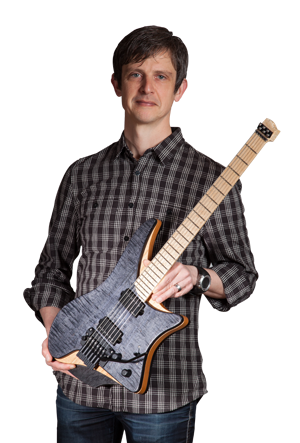I am leaning towards building the bridge in aluminum after all. First of all it will be easier for me to machine. Secondly, I got the new Stewart MacDonald catalog the other day and noticed several bridge parts in both aluminum and composites. I thought that only heavy materials like brass and steel were ever used for their sound qualities, but now I am willing to give it a go. Lastly, it will look good along with the Lace Alumitones that I am planning to use. Here are some sample looks: If I do go with the aluminum base plate, I would have to go with something like the bottom left design with hardened steel inserts for the fulcrums. Why not make it Floyd Rose drop-in compatible? It would save creating a router template and custom parts for springs, etc. It shouldn’t be any great news to anyone that a tapered fingerboard radius is superior to an even one. I’ve seen all kinds of radii listed, but decided to put some science to it and prove it to myself which one to go with. A fretboard can be considered as a small slice of a cone like below: It turns out that starting with a 305 mm (12″) radius...
Learn MoreI sent Rick Toone an e-mail to ask him about his stunning Orchid design, which uses a fixed truss rod and a trapezoidal neck shape. The conversation appears here: My question: “Did you arrive at the alloy and dimensions through any science? I was thinking 7075 or 7021 T6 aluminum, which on paper is stiffer and stronger than 6063 (although, I have arrived at that fact only through reading catalogues – I am no expert.) With the twisted neck that I want, 6063 would probably be more suited than the 7*** series, so it would be good if it worked. I am still a little concerned that the neck might flex. How have your experiences been?” Rick’s swift response (published with permission): “My experience with the square aluminum barstock has been excellent. Despite an almost inability to flex the barstock by hand (on the workbench), the pull of four bass strings in a 32″ scale length is enough to slightly flex the neck (less than the thickness of a business card) at the 12th fret. Astonishingly powerful. If you are building a six string guitar, the aluminum barstock would likely have unmeasurable flex. So my intuition tells me. One potential problem would be the neck thickens (as perceived by...
Learn MoreI have spent some time getting the body shape in electronic form and finalizing the bridge design. The headstock (what there will be of it) remains to be designed. Then I have some experimenting to do with the actual neck build. Tomorrow I go back to work, so progress will be slower I’m afraid, but I will try to keep up the momentum. I have a couple of leads on people with proper workshops who can help with the metal work. I have tried to revive my old logo, which entailed scanning the back of an old binder. I might have it in electronic form on some old backup CDs, but will see if I can’t get it done...
Learn MoreI have been thinking a lot about what the twisted neck design will do to the stability of the neck and the truss rod. I did some sketches to see how the center of the rotation would affect the neck. The picture above shows a twisted fingerboard seen from the short end. The leaning lines on the sides illustrate the width of a would be nut once the fingerboard had been cut to size. The way it looked at first (to the left), the axis would make a big impact. The top left image has the center of rotation where the strings would be, the mid left has the center in the center of the fingerboard and the bottom left has the center in the center of the would be neck. But if you would imagine that you lay the neck flat on a table and rotated it and then looked again from the short end, you would see the images on the right hand side. In the illustration, I have simply moved the twisted piece on the X-axis until the centers of the fingerboards align. It seems that the center of the rotation of the twist can be compensated for. I have been pondering using a twisted aluminum...
Learn More


